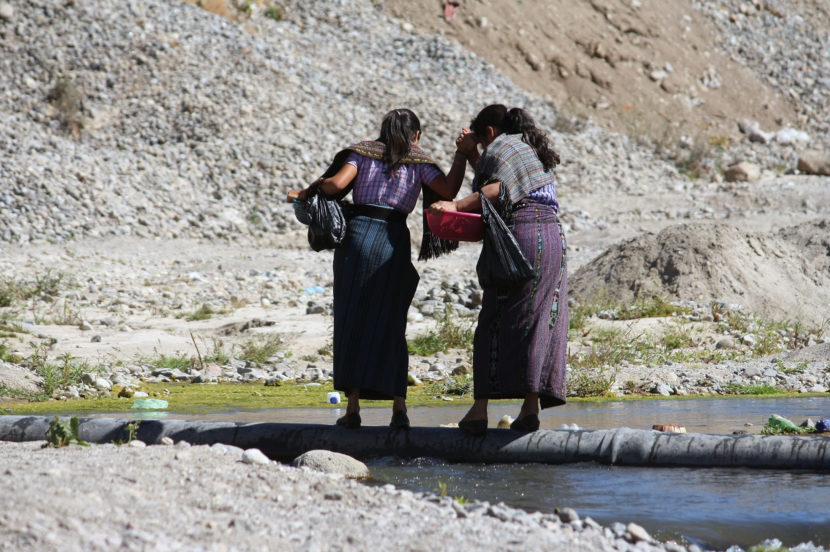Sexual violence against girls is a widespread and deeply rooted issue in Guatemala, often used as a tool to control and harm their bodies and futures. The alarming numbers of reported cases of sexual violence by girls have pushed the government to adopt a social protection programme called “Vida Programme” which is aimed at providing cash assistance to pregnant girls and mothers under 14. However, the measure presents some limits in its application and some further efforts need to be made to protect girls from sexual violence
Gender violence is not new in Guatemala
Violence against women has been a continuum in the history of Guatemala and gender violence was perpetuated as a tool of submission and control of women’s bodies and lives. This is also based on the patriarchal and conservative culture added to a fragile security and legal system that breeds impunity (UNWOMEN, n.d.).
Guatemala was the scene of a 36-year civil war. The Guatemalan Commission for Historical Clarification (CHC) which was created to clarify human rights violations related to the internal conflict that hit Guatemala from 1960 to 1996, found that sexual violence was prevalent during the three decades of the conflict.
The CHC recognized that the figures on sexual violence were underestimated in relation to other human rights violations, and reported that 2.38 percent of all the 42,275 registered human rights violations corresponded to sexual violence. Only 285 cases of the 1,465 reported at the time, could be documented by the Commission. The Court sanctioned the lack of diligence to investigate and prosecute sex crimes as well as the absence of policies to prevent them as a message of impunity and permissiveness (UNWOMEN, n.d.).
Unreported cases of sexual violence far outweigh the reported
A recent report published by the Human Rights Watch captured the phenomenon of sexual violence which is affecting the girls in Guatemala. According to the data collected, over one-third of women in Guatemala (34.5 percent) have experienced sexual violence in their lifetime. Girls are far more likely to report sexual violence (88 percent) than boys (12 percent) in Guatemala (HRW, 2025).
While official figures vary, between January 2018 and June 2024, the National Institute of Forensic Sciences (INACIF) examined 27,660 cases of sexual violence or child pregnancies in Guatemala. 24,441 of those cases involved a girl who was fourteen or younger, which is the legal age of consent in the country. In just the first half of 2024 alone, INACIF evaluated 1,987 cases of sexual violence against girls (James, Mehta, 2025).
In addition to this, of those who report sexual violence, few achieve justice. Between January 2018 and October 2023, a total of 6,697 cases of sexual violence against girls under 14 were dismissed and only 102 people were convicted in cases of pregnant girls under 14 who are survivors of sexual violence (HRW, 2025).
Despite the alarming nature of the data, the true magnitude of sexual violence is greater. It is estimated that for every reported case, there are five unreported cases (Izquierdo, 2024). Experts believe that these figures do not represent the true number of cases, as many of the victims involved often live in poverty and come from rural Indigenous communities that have little access to public services. Without adequate education and health services, young girls may not recognize early pregnancy signs, delaying healthcare access and worsening the impacts of forced pregnancies (James, Mehta, 2025).
Girls survivors of sexual violence face several barriers
Girls who are survivors of sexual violence face numerous barriers to accessing essential health care, education, social security, and justice (HRW, 2025). The consequences linked to those obstacles may produce negative impacts on their health and well-being, but also they hinder their development and the possibility for them to improve their economic and social situation which would better support them to escape the cycle of violence.

“Sexual violence remains a pervasive and systemic issue in Guatemala, disproportionally affecting girls under age 14. Guatemala’s failure to take adequate steps to prevent and end sexual violence and forced pregnancies among girls can have life-threatening consequences, including risks to girls’ physical and mental health, and can profoundly affect the realization of their economic, social, and cultural rights.”
– Cristina Quijano Carrasco (HRW, 2025)
Limited access to health services
Girls in Guatemala face long travel distances, staff shortages, and inadequate resources, preventing access to essential healthcare, including emergency contraception and prenatal care. Stigma and lack of awareness hinder legal abortion access (HRW, 2025).
Lack of educational opportunities
The education system fails to support pregnant girls and young mothers, with high dropout rates driven by stigma, family pressure, and violence. In 2024, only 213 pregnant students were enrolled nationwide (HRW, 2025).
Stigma and social exclusion
Societal stigma labels girls as “impure,” blaming them for their abuse. The lack of policies to support pregnant or young mothers in education leaves them without the necessary academic, social, and emotional support (HRW, 2025).
Limited access to justice
Systemic failures in the justice system lead to the dismissal of many cases of sexual violence against girls. Between 2018 and 2023, over 6,000 cases were dismissed, and convictions remain rare (HRW, 2025).
Even when cases proceed, accountability remains rare: judges issued just 136 preliminary indictments between January 2018 and September 2023 and 102 rape convictions between January 2018 and October 2023 in cases involving pregnant girls under 14 who are survivors of sexual violence (HRW, 2025).
Supporting girls survivors of sexual violence through social protection
One key measure which could support pregnant girls and mothers is social protection programs. The government’s “Vida Programme” was born with this purpose. It is intended to provide cash assistance to pregnant girls and mothers under 14.
However, it has low coverage due to its restrictive eligibility requirements and onerous bureaucratic hurdles. In 2024, only 129 girls were enrolled in the program, even though 1,953 girls under 14 gave birth that year (HRW, 2025). This is given to the fact that the only beneficiaries of the programme are pregnant girls and adolescent victims of sexual violence or mothers (with children under 5 years of age) whose cases have been prosecuted (protection measures granted by a children’s judge) (Planovi, 2020).
Moreover, one of the programme’s greatest challenges is to orient its actions towards the restitution of the human rights of the girl or adolescent victim of violence and supporting the recovery of her life plan. This entails reviewing the criteria for the program’s responsibilities towards both the victims and the state in this context. It also includes the need to review the criteria for the permanence of girls as beneficiaries of the Vida Programme (Planovi, 2020).
Gender-sensitive and child-centred justice system
The failings of the justice system indicate a lack of a gender-sensitive and child-centred approach in legal processes. Survivors of sexual violence encounter numerous barriers, including gender-based stereotypes, mistreatment, and limited access to government offices. Indigenous girls and deaf girls face additional challenges due to language barriers and a lack of culturally sensitive trained interpreters for Indigenous languages and sign language.
The gaps in justice are further compounded by an overloaded judicial system that leads to severe delays (HRW, 2025). Moreover, the absence of a sustainable and institutionalised training and capacity-building programme on the causes and consequences of Violence Against Women (VAW) for all justice sector operators and related bodies. Overcoming the tendency to what has so far been considered ‘awareness-raising’ in relation to the problem and moving towards continuous training processes that are incorporated into the actions that the government carries out for the qualification of public servants is a challenge (Planovi, 2020).
“Without meaningful reforms – including strengthening prevention, services, and access to justice – girls in Guatemala will continue to face shocking levels of sexual violence and insurmountable barriers to realizing their rights. The government needs to take urgent action to ensure that girls who are survivors of sexual violence have access to the health care, education, social security, and the legal protections to which they are entitled, in order to recover and rebuild their lives.”
– Cristina Quijano Carrasco (HRW, 2025)

As an NGO, Humanium is strongly committed to supporting girls’ rights and providing effective support to survivors of violence. In our work, we raise awareness on critical topics and promote best practices to improve the implementation of children’s rights around the world. You can also ask for help in the case of a violation of children’s rights through our legal helpline. If you want to support our work, please consider making a donation, volunteering or becoming a member.
Written by Arianna Braga
References:
HRW (2025). Guatemala: Failed Response to Sexual Violence Against Girls – Inadequate Health Care, Education, Social Security, Justice for Young Survivors. Retrieved from the Human Rights Watch (HRW) at https://www.hrw.org/news/2025/02/18/guatemala-failed-response-sexual-violence-against-girls, accessed on 4 March 2025.
Izquierdo, S. (2024). Support for Young Sexual Violence Survivors in Guatemala. Retrieved from UNICEF USA at https://www.unicefusa.org/stories/support-young-sexual-violence-survivors-guatemala, accessed on 4 March 2025.
James N., Mehta D. (2025). Women This Week: Girls Experiencing Significant Rate of Sexual Violence in Guatemala. Retrieved from Council on Foreign Relations at https://www.cfr.org/blog/women-week-girls-experiencing-significant-rate-sexual-violence-guatemala, accessed on 4 March 2025.
Planovi (2020). Plan Nacional para la Prevención y Erradicación de la Violencia Contra las Mujeres 2020-2029 (Planovi). Retrived from Secretaría Presidencial de la Mujer at https://seprem.gob.gt/wp-content/uploads/Planovi-2020-2029.pdf, accessed on 4 March 2025.
UNWOMEN (n.d.). Country page on Guatemala. Retrieved from UNWOMEN at https://lac.unwomen.org/en/donde-estamos/guatemala, accessed on 4 March 2025.


